I have studied the child. I have taken what the child has given me and expressed it and that is what is called the Montessori method.
— Dr. Maria Montessori
The Method
Montessori education offers a unique experience designed to help children maximize their potential; an educational environment that is purposefully designed to meet their developmental needs. Working in an optimally prepared environment, the trained adult will observe and connect the children with exactly what they need at that very moment to thrive.
The advantage of the Montessori method is that it supports the child’s natural inclinations towards learning and self-improvement. It seeks to provide the child with freedom — a freedom acquired through well-ordered action. Taking this approach liberates the child’s physcial, and intellectual energies, but in the construct of an ordered environment. Children learn by doing and are lovers of purposeful work, spontaneously chosen and carried out with profound joy.
Montessori education attends to the total development of the child – social, emotional, intellectual, physical and spiritual.
Renasissance Montessori School firmly believes that a necessary aspect of man’s freedom lies in his recognition of the Truth. As a part of this conviction, we believe that Catholic instruction and practical exercises are integral to true success in the implementation of the Montessori method. Renaissance’s approach to the education of the whole person is dependent upon the anthropomorphic realities of the human person, as endowed by our Creator and as taught and explained by our Catholic Faith.
SPIRITUAL DEVELOPMENT
The child’s spiritual development is nurtured and respected in a rare way in the Montessori environment.
Central to the mission of Renaissance Montessori School is the Catechesis of the Good Shepherd, a unique approach to the religious formation of children. Begun by biblical scholar Sofia Cavalletti in 1954, it is grounded in prayer, scripture, liturgy, and the Montessori method.
Dr. Maria Montessori herself was a devout Catholic and added a room for religious work to her schools in 1922 that she called an atrium. The word atrium comes from the early church, as it was in the entryway (the atrium) of the ancient Basilica where people prepared for baptism.
Similar to the Montessori classroom, the atrium is a place for child-centered exploration. In the Catechesis, we follow the child into the depths of his or her relationship with God. God has already formed a relationship with the child; the atrium helps foster that relationship. A trained catechist prepares the environment for the children and offers presentations on scripture, biblical geography and history, liturgy, and prayer.
The children also witness the adult staff members living their faith in a natural and joyous manner. Meeting the spiritual needs as well as the intellectual needs of the young child in a specially prepared place is an integral part of the learning environment at Renaissance.
BUT what exactly is Montessori Education?
At its core, it simply is a way of being with children that allows each child to develop fully into the person he or she was destined to be. Just as you make every effort to ensure your home is loving and safe – so your child feels secure and well-adjusted – we work diligently to ensure the physical environment, the teachers and the student community will meet your child’s needs with respect and support at each step in his educational journey.
The Montessori environment has three essential parts: the teacher, the materials, and the children. Instead of expecting that he pays attention to the teacher in front of a class of 30 children, it is the Montessori teacher, or guide, who observes and responds to your child’s needs and interests which fosters a trusting relationship – an education partnership of sorts – in which he will have faith that the adult truly understands and respects him for the human being into which he is transforming. The uniquely designed materials offer first-hand experiences for the children to discover and apply their newly acquired knowledge. The children in the community observe and learn from each other through free movement and choice within the environment. All three work together in sync with the needs of the community and the individuals it’s comprised of.
Our world doesn’t need more test takers, memorizers or followers. Now, more than ever, we need critical thinkers, entrepreneurs and do-ers. Montessori education prepares children to take on the future with confidence and zeal, propelled by the gift of self-knowledge and a lifelong passion for learning.
MONTESSORI DEVELOPMENT PLANES
The transformation of children from birth to adulthood occurs through a series of developmental planes. Montessori practice changes in scope and manner to embrace the child’s changing characteristics and interests.
The first plane of development occurs from birth to age six. At this stage, children are sensorial explorers, constructing their intellects by absorbing every aspect of their environment, their language and their culture.
From age 6 to 12, children become conceptual explorers. They develop their powers of abstraction and imagination, and apply their knowledge to discover and expand their worlds further.
The years between 12 and 18 see the children become humanistic explorers, seeking to understand their place in society and their opportunity to contribute to it.
From 18 to 24, as young adults, they become specialized explorers, seeking a niche from which to contribute to universal dialogue.




